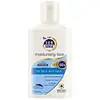What's inside
What's inside
 Key Ingredients
Key Ingredients

 Benefits
Benefits

 Concerns
Concerns

 Ingredients Side-by-side
Ingredients Side-by-side

Butyl Methoxydibenzoylmethane 3%
UV AbsorberHomosalate 5%
Skin ConditioningEthylhexyl Salicylate 3%
UV AbsorberOctocrylene 7%
UV AbsorberWater
Skin ConditioningCarthamus Tinctorius Oleosomes
EmollientButylene Glycol
HumectantDimethicone
EmollientC12-15 Alkyl Benzoate
AntimicrobialPropanediol
SolventPolysorbate 80
EmulsifyingPalmitoyl Tetrapeptide-7
Skin ConditioningDipotassium Glycyrrhizate
HumectantAniba Rosodora Wood Oil
AstringentCamellia Sinensis Leaf Extract
AntimicrobialHelianthus Annuus Seed Oil
EmollientPelargonium Graveolens Flower Oil
MaskingEugenia Caryophyllus Leaf Oil
MaskingSaccharomyces Cerevisiae Extract
Skin ConditioningLaminaria Digitata Extract
Skin ProtectingRosa Damascena Flower Oil
MaskingEugenia Caryophyllus Bud Oil
MaskingCitrus Limon Peel Oil
MaskingCymbopogon Schoenanthus Oil
MaskingCymbopogon Martini Oil
MaskingCupressus Sempervirens Leaf Oil
MaskingCitrus Limon Peel Extract
EmollientEucalyptus Globulus Leaf Oil
PerfumingTocopherol
AntioxidantSqualane
EmollientCaprylyl Glycol
EmollientCarnosine
Skin ConditioningAcrylates/C10-30 Alkyl Acrylate Crosspolymer
Emulsion StabilisingLecithin
EmollientUrea
BufferingCaprylic/Capric Triglyceride
MaskingGlycerin
HumectantPentylene Glycol
Skin ConditioningBisabolol
MaskingGlucosamine Hcl
Ethylhexylglycerin
Skin Conditioning1,2-Hexanediol
Skin ConditioningGluconolactone
Skin ConditioningPolysorbate 60
EmulsifyingTrisodium Ethylenediamine Disuccinate
Sorbitan Isostearate
EmulsifyingDecyl Glucoside
CleansingAminomethyl Propanol
BufferingHydroxyethyl Acrylate/Sodium Acryloyldimethyl Taurate Copolymer
Emulsion StabilisingPolysilicone-11
Sodium Acrylates Copolymer
Phenethyl Alcohol
MaskingSodium Benzoate
MaskingLinalool
PerfumingEugenol
PerfumingLimonene
PerfumingCitronellol
PerfumingGeraniol
PerfumingBenzyl Benzoate
AntimicrobialCitral
PerfumingCI 77891
Cosmetic ColorantButyl Methoxydibenzoylmethane 3%, Homosalate 5%, Ethylhexyl Salicylate 3%, Octocrylene 7%, Water, Carthamus Tinctorius Oleosomes, Butylene Glycol, Dimethicone, C12-15 Alkyl Benzoate, Propanediol, Polysorbate 80, Palmitoyl Tetrapeptide-7, Dipotassium Glycyrrhizate, Aniba Rosodora Wood Oil, Camellia Sinensis Leaf Extract, Helianthus Annuus Seed Oil, Pelargonium Graveolens Flower Oil, Eugenia Caryophyllus Leaf Oil, Saccharomyces Cerevisiae Extract, Laminaria Digitata Extract, Rosa Damascena Flower Oil, Eugenia Caryophyllus Bud Oil, Citrus Limon Peel Oil, Cymbopogon Schoenanthus Oil, Cymbopogon Martini Oil, Cupressus Sempervirens Leaf Oil, Citrus Limon Peel Extract, Eucalyptus Globulus Leaf Oil, Tocopherol, Squalane, Caprylyl Glycol, Carnosine, Acrylates/C10-30 Alkyl Acrylate Crosspolymer, Lecithin, Urea, Caprylic/Capric Triglyceride, Glycerin, Pentylene Glycol, Bisabolol, Glucosamine Hcl, Ethylhexylglycerin, 1,2-Hexanediol, Gluconolactone, Polysorbate 60, Trisodium Ethylenediamine Disuccinate, Sorbitan Isostearate, Decyl Glucoside, Aminomethyl Propanol, Hydroxyethyl Acrylate/Sodium Acryloyldimethyl Taurate Copolymer, Polysilicone-11, Sodium Acrylates Copolymer, Phenethyl Alcohol, Sodium Benzoate, Linalool, Eugenol, Limonene, Citronellol, Geraniol, Benzyl Benzoate, Citral, CI 77891
Bis-Ethylhexyloxyphenol Methoxyphenyl Triazine
Skin ConditioningMethylene Bis-Benzotriazolyl Tetramethylbutylphenol
UV FilterEthylhexyl Salicylate
UV AbsorberC12-15 Alkyl Benzoate
AntimicrobialMagnesium Aluminum Silicate
AbsorbentCarbomer
Emulsion StabilisingCitric Acid
BufferingDecyl Glucoside
CleansingDiisopropyl Adipate
EmollientGlycerin
HumectantGlyceryl Stearate
EmollientIsopropyl Palmitate
EmollientNiacinamide
SmoothingPEG-100 Stearate
Potassium Cetyl Phosphate
EmulsifyingPropylene Glycol
HumectantWater
Skin ConditioningMethyl Dihydroxybenzoate
Propylparaben
PreservativeXanthan Gum
EmulsifyingBis-Ethylhexyloxyphenol Methoxyphenyl Triazine, Methylene Bis-Benzotriazolyl Tetramethylbutylphenol, Ethylhexyl Salicylate, C12-15 Alkyl Benzoate, Magnesium Aluminum Silicate, Carbomer, Citric Acid, Decyl Glucoside, Diisopropyl Adipate, Glycerin, Glyceryl Stearate, Isopropyl Palmitate, Niacinamide, PEG-100 Stearate, Potassium Cetyl Phosphate, Propylene Glycol, Water, Methyl Dihydroxybenzoate, Propylparaben, Xanthan Gum
 Reviews
Reviews

Ingredients Explained
These ingredients are found in both products.
Ingredients higher up in an ingredient list are typically present in a larger amount.
C12-15 Alkyl Benzoate is made up of Benzoic Acid and long chain alcohols. It has a low molecular weight.
C12-15 Alkyl Benzoate is an emollient and texture enhancer. Due to its solubility, it is often used in sunscreens to help evenly distribute active ingredients.
As an emollient, C12-15 Alkyl Benzoate helps soften and hydrate your skin. Emollients create a film on your skin that traps moisture within.
This ingredient has been reported to cause eye irritation.
Learn more about C12-15 Alkyl BenzoateDecyl Glucoside is a glucose-based surfactant and emulsion stabilizer. It is created by reacting glucose with the fatty acids from plants.
Surfactants help clean the skin by trapping oil, sebum, and dirt to be washed away. As an emulsion stabilizer, it stabilizes the ingredients in a product by preventing them from separating.
This ingredient is biodegradable and non-toxic. This ingredient is commonly found in baby shampoos.
Decyl Glucoside is sometimes used to stabilize the UV filter Tinosorb.
Learn more about Decyl GlucosideEthylhexyl Salicylate is an organic compound used to block UV rays. It primarily absorbs UVB rays but offers a small amount of UVA protection as well.
Commonly found in sunscreens, Ethylhexyl Salicylate is created from salicylic acid and 2-ethylhexanol. You might know salicylic acid as the effective acne fighter ingredient and BHA.
The ethylhexanol in this ingredient is a fatty alcohol and helps hydrate your skin, similar to oils. It is an emollient, which means it traps moisture into the skin.
According to manufacturers, Ethylhexyl Salicylate absorbs UV wavelength of 295-315 nm, with a peak absorption at 307-310 nm. UVA rays are linked to long term skin damage, such as hyperpigmentation. UVB rays emit more energy and are capable of damaging our DNA. UVB rays cause sunburn.
Learn more about Ethylhexyl SalicylateGlycerin is already naturally found in your skin. It helps moisturize and protect your skin.
A study from 2016 found glycerin to be more effective as a humectant than AHAs and hyaluronic acid.
As a humectant, it helps the skin stay hydrated by pulling moisture to your skin. The low molecular weight of glycerin allows it to pull moisture into the deeper layers of your skin.
Hydrated skin improves your skin barrier; Your skin barrier helps protect against irritants and bacteria.
Glycerin has also been found to have antimicrobial and antiviral properties. Due to these properties, glycerin is often used in wound and burn treatments.
In cosmetics, glycerin is usually derived from plants such as soybean or palm. However, it can also be sourced from animals, such as tallow or animal fat.
This ingredient is organic, colorless, odorless, and non-toxic.
Glycerin is the name for this ingredient in American English. British English uses Glycerol/Glycerine.
Learn more about GlycerinWater. It's the most common cosmetic ingredient of all. You'll usually see it at the top of ingredient lists, meaning that it makes up the largest part of the product.
So why is it so popular? Water most often acts as a solvent - this means that it helps dissolve other ingredients into the formulation.
You'll also recognize water as that liquid we all need to stay alive. If you see this, drink a glass of water. Stay hydrated!
Learn more about Water